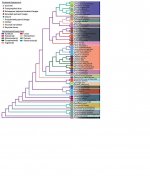Fred Ruhe
Well-known member

Amanda R. Falk, James C. Lamsdell and Enpu Gong, 2020
Principal component analysis of avian hind limb and foot morphometrics and the relationship between ecology and phylogeny
Paleobiology (advance online publication)
DOI: https://doi.org/10.1017/pab.2020.39
https://www.cambridge.org/core/jour...nd-phylogeny/144C8D8E6E3ECD3A119A3AE7A5401FC2
Abstract:
Principal component analysis has been used to test for similarities in ecology and life habit between modern and fossil birds; however, the two main portions of the hind limb—the foot and the long bone elements—have not been examined separately. We examine the potential links between morphology, ecology, and phylogeny through a synthesis of phylogenetic paleoecological methods and morphospace analysis. Both hind limb morphologies and species’ ecologies exhibit extreme phylogenetic clumping, although these patterns are at least partially explainable by a Brownian motion style of evolution. Some morphologies are strongly correlated with particular ecologies, while some ecologies are occupied by a variety of morphologies. Within the morphospace analyses, the length of the hallux (toe I) is the most defining characteristic of the entire hind limb. The foot and hind limb are represented on different axes when all measurements are considered in an analysis, suggesting that these structures undergo morphological change separately from each other. Early birds tend to cluster together, representing an unspecialized basal foot morphotype and a hind limb reliant on hip-driven, not knee-driven, locomotion. Direct links between morphology, ecology, and phylogeny are unclear and complicated and may be biased due to sample size (~60 species). This study should be treated as a preliminary analysis that further studies, especially those examining the vast diversity of modern birds, can build upon.
Enjoy,
Fred
Principal component analysis of avian hind limb and foot morphometrics and the relationship between ecology and phylogeny
Paleobiology (advance online publication)
DOI: https://doi.org/10.1017/pab.2020.39
https://www.cambridge.org/core/jour...nd-phylogeny/144C8D8E6E3ECD3A119A3AE7A5401FC2
Abstract:
Principal component analysis has been used to test for similarities in ecology and life habit between modern and fossil birds; however, the two main portions of the hind limb—the foot and the long bone elements—have not been examined separately. We examine the potential links between morphology, ecology, and phylogeny through a synthesis of phylogenetic paleoecological methods and morphospace analysis. Both hind limb morphologies and species’ ecologies exhibit extreme phylogenetic clumping, although these patterns are at least partially explainable by a Brownian motion style of evolution. Some morphologies are strongly correlated with particular ecologies, while some ecologies are occupied by a variety of morphologies. Within the morphospace analyses, the length of the hallux (toe I) is the most defining characteristic of the entire hind limb. The foot and hind limb are represented on different axes when all measurements are considered in an analysis, suggesting that these structures undergo morphological change separately from each other. Early birds tend to cluster together, representing an unspecialized basal foot morphotype and a hind limb reliant on hip-driven, not knee-driven, locomotion. Direct links between morphology, ecology, and phylogeny are unclear and complicated and may be biased due to sample size (~60 species). This study should be treated as a preliminary analysis that further studies, especially those examining the vast diversity of modern birds, can build upon.
Enjoy,
Fred




